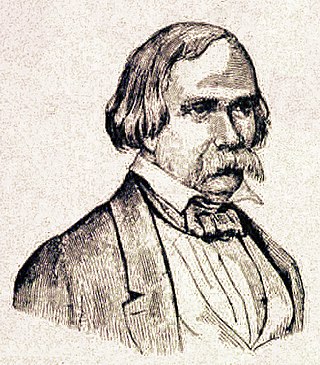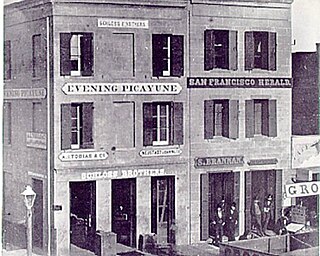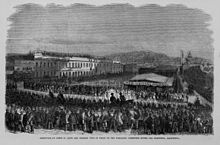
Samuel S. Brannan was an American settler, businessman, journalist, and prominent Mormon who founded the California Star, the first newspaper in San Francisco, California. He is also considered the first to publicize the California Gold Rush and was California's first millionaire. He used the profits from his stores to buy large tracts of real estate. He helped form the first vigilance committee in San Francisco and was disfellowshiped from the Church of Jesus Christ of Latter-day Saints because of his actions within the vigilance committee. Brannan's wife divorced him and he was forced to liquidate much of his real estate to pay her one-half of their assets. He died poor and in relative obscurity.

John Neely Johnson was an American lawyer and politician. He was elected as the fourth governor of California from 1856 to 1858, and later appointed justice to the Nevada Supreme Court from 1867 to 1871. As a member of the American Party, Johnson remains one of only three members of a third party to be elected to the California governorship.
A vigilance committee is a group of private citizens who take it upon themselves to administer law and order or exercise power in places where they consider the governmental structures or actions inadequate. Some vigilance committees engaged in forms of vigilantism such as aiding fugitive slaves in violation of the laws on the books at the time. Beginning in the 1830s committees of abolitionists worked to free enslaved people and transport them to freedom.

Volney Erskine Howard was an American lawyer, statesman, and jurist.

Charles James Brenham was an American politician, banker, and steamboat captain. He served as the 2nd mayor of San Francisco in 1851, and again as the 4th mayor of San Francisco from 1852 until 1853.
The Sydney Ducks was the name given to a gang of criminal immigrants from Australia in San Francisco, during the mid-19th century. Because many of these criminals came from the well-known British penal colonies in Australia, and were known to commit arson, they were blamed for an 1849 fire that devastated the heart of San Francisco, as well as the rampant crime in the city at the time.

The Barbary Coast was a red-light district during the second half of the 19th and early 20th centuries in San Francisco that featured dance halls, concert saloons, bars, jazz clubs, variety shows, and brothels. Its nine block area was centered on a three block stretch of Pacific Street, now Pacific Avenue, between Montgomery and Stockton Streets. Pacific Street was the first street to cut through the hills of San Francisco, starting near Portsmouth Square and continuing east to the first shipping docks at Buena Vista Cove.

McGowan's War was a bloodless war that took place in Yale, British Columbia in the fall of 1858. The conflict posed a threat to the newly established British authority on the British Columbia mainland, at the onset of the Fraser Canyon Gold Rush. It was called Ned McGowan's War after one of the conflict's main antagonists.

James Van Ness was an American politician who served as the 6th Mayor of San Francisco from 1855 to 1856.

William Tell Coleman (1824–1893) was an American pioneer in the settlement of California.

Henry Frederick Teschemacher served as the 9th mayor of San Francisco from October 3, 1859, to June 30, 1863.
The Superior Court of California of the County of San Francisco is the state superior court with jurisdiction over the City and County of San Francisco.
Jack Powers, whose real name was John A. Power, was an Irish-born American outlaw who emigrated to New York as a child and later served as a volunteer soldier in the Mexican–American War in the garrison of Santa Barbara, California. During the California Gold Rush, he was a well-known professional gambler and a famed horseman in the gold camps as well as in San Francisco, Santa Barbara and Los Angeles.

Edward McGowan was an American lawyer, Pennsylvania assemblyman, Judge of the California Court of Quarter Sessions, poet, Fraser Canyon gold seeker, adventurer, assistant sergeant-at-arms in the United States Congress, newspaper publisher and bon vivant instigator of the eponymous McGowan's War in colonial British Columbia.
The history of vigilante justice and the Montana Vigilantes began in 1863 in what was at the time a remote part of eastern Idaho Territory. Vigilante activities continued, although somewhat sporadically, through the Montana Territorial period until the territory became the state of Montana on November 8, 1889. Vigilantism arose because territorial law enforcement and the courts had very little power in the remote mining camps during the territorial period.

John Strother Griffin (1816–1898) was a surgeon attached to the General Stephen W. Kearney expedition from New Mexico to California, a landowner and founder of East Los Angeles and a member of the Common Council of the city of Los Angeles, where he was one of the first university-trained physicians to settle.

James King of William was a crusading San Francisco, California, newspaper editor whose assassination by James P. Casey, a member of the San Francisco Board of Supervisors in 1856 resulted in the establishment of the second San Francisco Vigilance Committee and changed the politics of the city. King was among the first newspapermen to be honored by the California Journalism Hall of Fame.

Belle Cora, also known as Arabella Ryan, was a madam of the Barbary Coast of San Francisco during the mid-nineteenth century. She rose to public attention in 1855 when her lover, Charles Cora, killed U.S. Marshal William H. Richardson after they had a conflict at the theater. She died in 1862.

The San Francisco Herald, or San Francisco Daily Herald, was a newspaper that was published from 1850 to 1862 in San Francisco, California. The paper stood out aggressively against crime and corruption associated with the California Gold Rush. The editors fought several duels with men whom they had offended. In 1856 the paper attacked the Vigilance Committee, which was taking the law into its own hands. Supporters of the committee withdrew their subscriptions and advertising, almost forcing the newspaper to close. However, the newspaper continued to be published with smaller circulation until 1862.
Vigilantism in the United States of America is defined as acts which violate societal limits which are intended to defend and protect the prevailing distribution of values and resources from some form of attack or some form of harm.
















